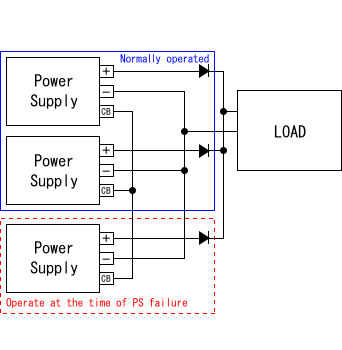1. Parallel operation
"Parallel operation" is the way increasing the output power by connecting in the parallel to supplement the lack of the output power. If the power supply is operated in the parallel, to use the power supply that has the parallel operation function ( the current balance function) is general. However, if the option "-P" is used or put the diode as a simple method the power supply that does not have the parallel operation function might be able to be used in the parallel operation.
2. Redundancy operation
2.1 Redundancy operation
"Redundancy operation" is also called " Backup operation". It is same as "Parallel operation" about the part connecting in the parallel, but its purpose is not to increase the output power. It is the way of connecting the reserve of the power supply to not stop the system even if the power supply become broken.
If the "Redundancy operation" is done, it is general to connect the reserve of the power supply in which rated current is same as the main power supply. Also, if the power supply is used in the parallel operation, same number of power supplies are needed. Please refer to Fig. 2.1.
2.2 N+1 Parallel Redundancy operation
In the general redundancy operation, if the system that has some power supplies connected in the parallel is composed, same number of power supplies as them are needed. Please refer to Fig. 2.2.
"N+1 parallel redundancy operation" is the way that several power supplies share the power needed to the system, and one power supply for redundancy is connected to the system.
This way can constitute the system that is cheaper than normal system when the power of the system is big, because of the following.
* The redundancy operation is constituted by increasing the quantity of the power supply and sharing the power.
* One of the power supply is used as the spare power supply because of not stopping the system even if one of the power supply becomes broken. Therefore, the spare power supply is enough even if its power is small.
And, if the power supply that has the function for the parallel operation is used, the output voltage of the power supply that has the function for the parallel operation is dropped when one of the power supply is broken. The function for the parallel operation tries to keep the output current 0A,
because the output current of the broken power supply is 0A.
Therefore, the power supply in which output voltage is not decreased even if another power supply is broken needs to be used, when the power supply is used for redundancy operation.

Fig.2.1 Example of normal redundancy operation

Fig.2.2 Example of N+1 parallel redundancy operation
Technical Product-related Inquires
e-mail:support@cosel.co.jp
